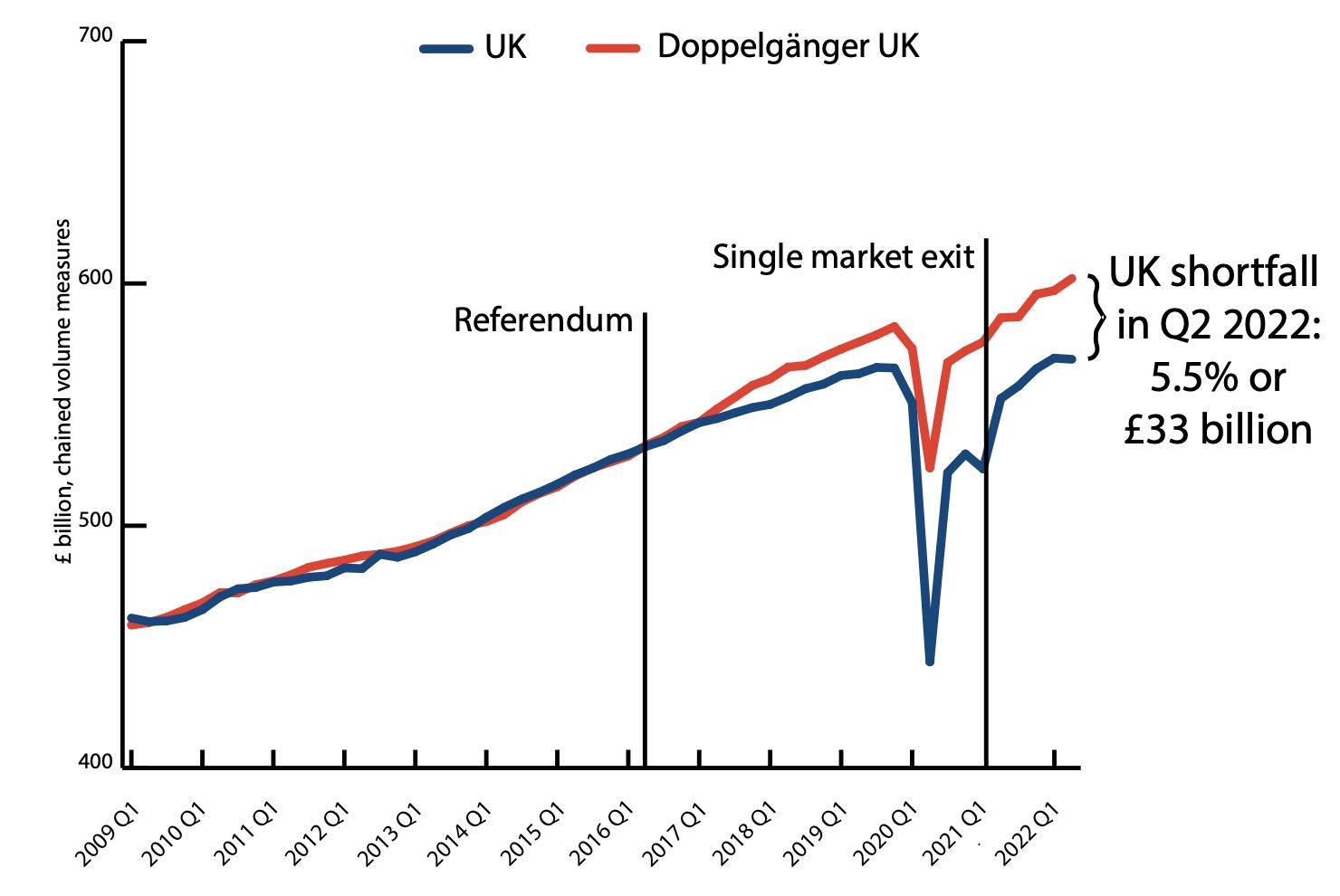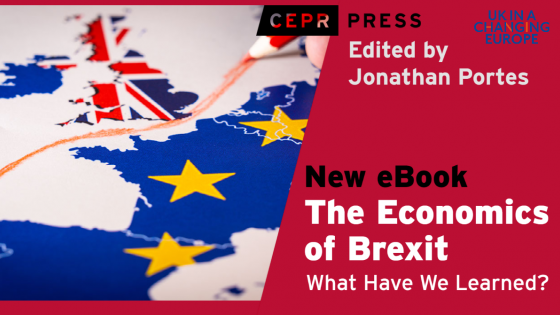One year ago, CEPR published a summary of the evidence on the economic impacts of Brexit on the UK economy (Portes 2022). Since then, the British public appears to have made up its mind on this topic: two-thirds think Brexit has damaged the economy, while even among Leave voters only one in five think the impact has been positive (UK in a Changing Europe 2023). The vast majority of economists would agree (and many would add a resounding ‘we told you so’). But that does not mean that we fully understand how, and to what extent, Brexit has affected the UK economy. In this column, I summarise the evidence across three key dimensions – trade, migration and investment – and then examine recent evidence on the overall macroeconomic impacts.
First, trade. The most obvious and direct impact of Brexit was to reintroduce significant barriers to trade between the UK and its largest trading partner, so it’s here that the impacts should be the most salient. And indeed, the headline result is that the UK’s trade performance has suffered considerably. The Office for Budget Responsibility notes that the UK’s ‘trade intensity’ (trade as a proportion of GDP) has fallen significantly, and considerably more than other advanced economies (OBR 2023).
Most academic analysis suggests that Brexit is at least partly responsible. Using synthetic differences-in-differences, Du et al. (2023) find that Brexit has had a large and continuing negative impact on UK goods exports, with particularly large impacts on smaller firms. Confirming this with more qualitative evidence, Bailey et al. (2023) find that the “imposition of new non-tariff barriers through Brexit has proved particularly challenging to smaller firms in manufacturing supply chains”.
However, Office for National Statistics trade data suggest that rather than seeing – as simple trade models of the impact of Brexit would imply – a sharp fall in our trade with the EU in both goods and services, goods trade has been weak across the board, while services trade has held up well (ONS 2023). Moreover, there is little evidence of a differential impact on UK exports to the EU compared to exports outside the EU (Freeman et al. 2022), although they also find that smaller firms have been more adversely affected.
There are plausible, but as yet unproven, explanations for this. On the one hand, conventional trade models fail to take full account of how Brexit has impacted the UK’s participation in global supply chains (Baldwin 2014). On the other hand, strength in service exports reflects the UK’s strong position in high value sectors like consultancy where there are few barriers to trade and where the pandemic has actually helped normalise the remote delivery of services (Hale and Fry 2023) . To further complicate the issue, there are numerous anomalies in the data. So while it’s reasonable to conclude that Brexit has damaged the UK’s trade performance, both the magnitude and the mechanisms remain open to question.
Second, immigration. Again, the obvious and direct impact of Brexit was to end free movement, and there’s no doubt that has restricted labour supply – net immigration from the EU, which peaked at over 200,000 a year at the time of the referendum, is now negative. That in turn has had, as predicted, some negative impacts both on specific sectors and the flexibility of the UK labour market as a whole (Portes and Springford 2023). The main impact has, again as predicted (Portes 2021), mostly been higher prices and reduced output in the affected sectors, rather than sharply higher wages. Indeed, it is notable that recent wage growth has actually been stronger is sectors such as finance than in sectors more directly affected by reduced migration flows (Bank of England 2023).
However, what was not predicted was the sharp rise in immigration from outside the EU, both for work and study, which – in numerical terms at least – has more than offset the reduction in EU migration. This has been driven by a number of factors, especially the relative liberalism of the post-Brexit system, refugee flows, and growth in international students (UK in a Changing Europe 2023b). While not all are strictly ‘Brexit impacts’, this shift in both the nature and national origin of migrants is very much consistent with the stated objectives of the new system (Portes 2023a). From this perspective, the short-term economic damage seen in sectors currently undergoing a painful adjustment process to the end of free movement will be more than offset by the longer-term benefits of shifting towards more selective, higher-skilled migration. While it’s too soon to tell whether these will materialise, again the picture is more nuanced than simply observing that Brexit has reduced migration from the EU.
Finally, investment. The relatively low level of business investment in the UK pre-dated Brexit, but both aggregate data and survey evidence strongly suggest that Brexit is at least in part responsible for the particularly poor performance since 2016, with investment perhaps 10% lower than it would otherwise have been. That in turn might translate to reduction in productivity, and hence output, of a little over 1% of GDP (Haskel and Martin 2023). One key question here is whether this reduction reflects, at least in part, Brexit-related uncertainty, in which case some catch-up might be expected.
So, taking all this together, what’s the bottom line? First, the public is right. Brexit has damaged the UK economy. But, inevitably, the mechanisms and hence the impacts have been considerably more complex than economists could incorporate in macroeconomic or trade models, with their inevitably simplifying assumptions. To simplify hugely, however, it would be reasonable to say that the impact on trade overall has been broadly consistent with predictions so far, that on immigration much less negative (and perhaps even positive) and on investment somewhat worse.
What does this mean for the UK economy overall? The best publicised estimate (Springford 2022) again uses a synthetic counterfactual methodology, very much following Campos et al. (2014), who used a similar method to estimate the (positive) impacts on UK GDP of EU membership. Springford finds a negative impact of about 5% since the vote to leave in 2016. However, in a recent critique, Gudgin and Lu (2023) argue that “[Springford’s] CER doppelganger index does not provide a credible measure of the impact of Brexit”.
However, as I explain in Portes (2023b), not only is Gudgin and Lu’s critique far from convincing on theoretical grounds, their alternative approach – a simple error correction mechanism – actually produces results which are functionally identical to Springford’s, as the two figures below show.
Figure 1 UK GDP vs synthetic counterfactual (Springford/Centre for European Reform)
Source: Springford (2022).
Figure 2 UK GDP vs ECM forecast (Gudgin and Lu methodology)
Source: Gudgin and Lu (2023).
However, it is important to note that techniques like this, which rely essentially on quantitative estimates of the change in relative UK economic performance after the Brexit vote, can by definition only measure the change in UK growth after 2016 relative to other countries. They cannot measure why it changed. While some or even most of that change may be attributable to Brexit, other factors – for example, as Gudgin and Lu argue, changes in US fiscal policy, or the acceleration of economic recovery in Greece – will also affect relative growth rates, as indeed will changes in the UK economic environment unrelated to Brexit. For example, the recent slowdown in UK labour supply growth is not primarily a Brexit phenomenon (OBR 2023).
It is also the case that UK growth performance in the period running up to the referendum compared well to that of other large European economies, and that the implicit assumption that this would have continued, absent Brexit, may well not be accurate. It seems likely that a substantial part but by no means all of the ‘underperformance’ – which, as Gudgin and Lu and others point out, is at least in part shared by some other large European countries – is unlikely to be the result of Brexit, and that both the estimates reported above are therefore too large.
Given this, it is helpful to supplement models such as those above with a qualitative description of other things that might have changed since 2016 to affect the UK’s relative growth trajectory, as well as comparing to ex ante estimates. For example, UK in a Changing Europe (2019) models the impacts of a potential ‘hard Brexit’ more or less along the lines of the actual Trade and Cooperation Agreement, combined with a relatively ‘liberal’ migration policy; in other words, something very similar to the actual policy outturn. This suggested that the negative impact would be between roughly 2% and 6% of GDP, with the large range reflecting uncertainty about productivity impacts. So far, the picture painted above seems broadly consistent with our analysis.
Can we narrow down the range? Given the UK’s poor investment performance, my judgement is that the upper end of that range seems more plausible, and – very roughly – perhaps half that impact has materialised so far, with the rest still to come though. My central view is therefore that the best estimate of the negative impact on Brexit on UK GDP to date is 2–3% of GDP. But, as the discussion above shows, the debate is far from over.
References
Bailey, D, L De Propris, A De Ruyter, D Hearne, and R Ortega-Argilés (2023), “Brexit, trade and UK advanced manufacturing sectors: a Midlands’ perspective”, Contemporary Social Science 18(2): 250-265.
Baldwin, R (2014), “Multilateralising 21st century regionalism”, VoxEU.org, 20 January.
Bank of England (2023), “Monetary Policy Summary and Minutes of the Monetary Policy Committee”, June 2023.
Campos, N, F Coricelli and L Moretti (2014), “Economic growth and political integration: Estimating the benefits from membership in the EU using the synthetic counterfactuals method,” CEPR Discussion Paper 9968.
Du, J, E Satoglu and O Shepotylo (2023), “How did Brexit affect UK trade?”, Contemporary Social Science 18(2): 266-283.
Freeman, R, K Manova, T Prayer and T Sampson (2022) “UK trade in the wake of Brexit”, CEP Discussion Paper 1847.
Fry, E and S Hale, S (2023) “Open for business? UK trade performance since leaving the EU”, Resolution Foundation, February.
Gudgin, G, and S Lu (2023), "The CER doppelganger index does not provide a credible measure of the impact of Brexit”, UK in a Changing Europe Working Paper 5.
Haskel, J and J Martin (2023), “How has Brexit affected business investment in the UK”, Economics Observatory, March.
OBR – Office for Budget Responsibility (2023), “Economic and Fiscal Outlook”, March.
ONS – Office for National Statistics (2023), “UK trade”, April.
Portes, J (2021), “Migration and Wages after Covid and Brexit”, UK in Changing Europe, July.
Portes, J (ed) (2022), The Economics of Brexit: What Have We Learned?, CEPR Press.
Portes, J (2023a) “Why the panic over rising immigration? The post-Brexit system is working”, The Guardian, May.
Portes, J (2023b), “How much has Brexit cost the UK economy”, UK in a Changing Europe, June.
Portes, J and J Springford (2023), “The impact of the post-Brexit migration system on the UK labour market”, Contemporary Social Science 18(2): 132-149.
Springford, J (2022) “The cost of Brexit to June 2022”, Centre for European Reform, November.
UK in a Changing Europe (2019) “The economic impact of Boris Johnson’s Brexit proposals”, October 2019.
UK in a Changing Europe (2023), “Exploring Bregret: Initial Polling”,
UK in a Changing Europe (2023b), “Immigration after Brexit”, February.





